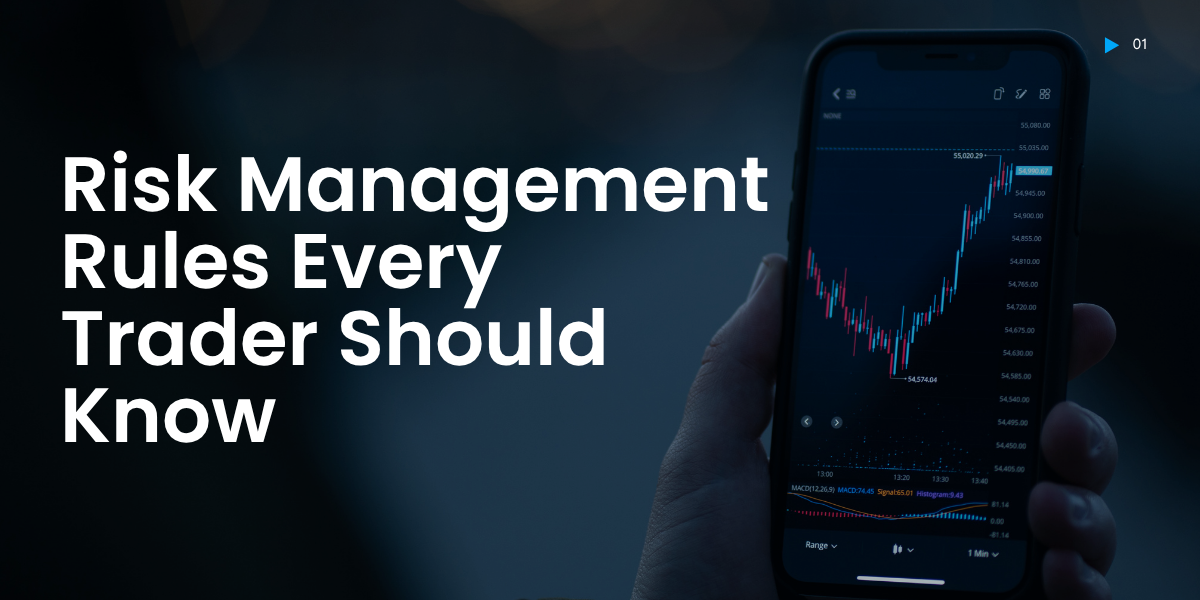If you have been trading for a while or are just getting into it, you’ve probably come across the word risk. It’s everywhere in the US financial landscape, and continues to affect many trading activities.
But what a lot of people don’t talk about is how to handle that risk in a way that doesn’t eat your account alive.
As a trader, you don’t need to avoid risk altogether, as that is not realistic. All you have to do is know how to control it, how to protect your capital, and how to trade without letting emotions take the wheel.

1. Never Risk More Than You Can Afford to Lose
Sounds simple, but most traders don’t follow it. People go all in thinking that one trade is going to change their lives. Through thorough market analysis and understanding of an asset, they invest a lot of money, hoping for high returns.
What they don’t know is that the markets can be unpredictable. Things can go south very fast, leaving them stressed, stuck, and chasing losses.
Before you enter any trade, ask yourself one thing: “If this money disappears right now, will I be okay?” If the answer is no, don’t place that trade.
Most experienced traders only risk about 1-2% of their total capital on a single position. That’s not a magic number. It’s just enough to give you room to breathe if things don’t go your way.
2. Set a Risk-to-Reward Ratio
Every trade should be worth the risk, and this is a decision you should make after conducting your market research and analysis. There’s no point risking £50 to maybe make £30. That’s just upside down. You want to be aiming for a setup where the potential reward is at least double what you’re risking.
Many traders use a 1:2 ratio as a base. That means if you’re risking £100, you should be trying to make at least £200 on the trade. Others shoot for 1:3 or even higher when the opportunity appears more favorable. It’s not about hitting home runs every time, but about stacking the odds so you can be wrong more than right and still come out on top.
Note that trading without a clear reward in mind is just throwing darts in the dark.
3. Use Stop-Loss Orders Religiously
Markets are unpredictable. No matter how confident you feel, anything can happen. News breaks, earnings miss, and global stuff shift sentiment in seconds. If you’re in a trade without a stop-loss order, you’re leaving your entire position at the mercy of chaos.
A stop-loss order acts like a seatbelt. It automatically closes your position when an asset’s price reduces up to a specified amount. This is so that you do not incur massive losses. You may not need stop-loss orders every time, but when something goes wrong, you’ll be glad you used them.
Place a stop-loss order at a level that makes technical sense. Not too tight that it gets hit by random market fluctuation, and not so far that it makes the whole trade pointless. Use price action, key levels, and recent volatility to determine a spot that provides a suitable trade space while still protecting your downside.
4. Diversify Your Portfolio
This one gets overlooked often, especially by newer traders who believe that focusing on a single investment will maximise their profitability. While this can be true, note that you will incur massive losses if all your money is riding on one idea and it fails.
Diversification is a buffer. It won’t stop losses from happening, but it spreads the damage. It could mean holding different types of assets like equities, commodities, and maybe a small amount of cryptocurrency. Or it could mean trading in different sectors, different time frames, or using more than one strategy.
The goal of portfolio diversification is not to own everything but to make sure you’re not completely exposed to just one thing going wrong.
5. Stick to a Trading Plan
Trading on instinct or emotions like excitement, greed, and FOMO might feel exciting, but it’s rarely profitable in the long run. You need rules and solid strategies to maximise your potential.
A trading plan should include what you trade, how often, what signals you use to enter and exit, how much you risk per trade, and how you will review performance. Without a plan, it’s easy to start improvising. And improvising usually leads to chasing losses, overtrading, and ignoring the risk factors we’re discussing here.
Note that your plan doesn’t need to be complicated. It just needs to be consistent. Therefore, find a trading journal and write it down, follow it, and refine it as you go.
If you need help getting started, platforms like the UK Investing Guide provide a comprehensive range of resources to help you build a structure that suits your style. Some reputable brokers across the US also feature learning materials to give you the best head start.
6. Limit Use of Leverage
Leverage or margin trading allows you to manage small trades using a larger capital. It can turn a small trade into a substantial profit or bring about massive losses. Leverage is powerful, but it can be dangerous if you don’t respect it or understand the associated risks.
Many brokers offer leverage limits to their users as a way to support them in achieving their investment goals. But just because it’s available doesn’t mean you should take it.
As a solid trader, ensure you stick to small amounts. Risk what you are comfortable losing to avoid emotional distress should the market move in the opposite direction. For instance, using 2:1 or 5:1 leverage gives you some extra firepower without putting your whole account at risk.
Remember, with high leverage, your margin for error disappears fast. One mistake, one surprise move, and you can lose a huge chunk of your capital before you even have time to react. So, start small and grow from there as you gain confidence and become more familiar with the market.
7. Review and Adjust Regularly
Markets change. What worked last month might stop working this month. That’s why reviewing your trades is just as important as placing them.
As mentioned earlier, having a journal is crucial and more essential for this purpose. Write down your reasons for entering a trade, how it played out, what went right, and what didn’t. Review it every week or two to understand the performances. Patterns will start to show up not just in the market, but also in your own decisions.
You will spot where you’re being too aggressive, too passive, or breaking your own rules without realizing. The sooner you catch those habits, the quicker you can adjust.
Risk Management in Trading FAQs
Below, we share some of the most commonly asked questions and their corresponding answers regarding risk management rules in trading.
-
Why is a Stop-Loss Important?
A stop-loss order secures a trade or position from incurring massive losses should a trade work out differently than expected. It gives you control over how much you lose, even when things go completely off the rails. It also helps you avoid making decisions based on emotions like fear.
-
What is a Good Risk-to-Reward Ratio for Trading?
1:2 is a decent starting point. That means you’re trying to make twice as much as you risk. With that setup, even if you only win half your trades, you’ll still be ahead. The key is consistency. Avoid situations where you risk a lot just to gain a little.
-
Can You Trade Without Leverage?
Absolutely. I usually encourage people to avoid leveraged trading as much as possible. Trading without leverage might slow things down a bit, but it’s a great way to learn how the market works without blowing up your account. You will focus more on the process instead of just chasing gains.
-
Is Diversification Necessary for Traders?
Yes. If you’re holding positions for more than a few hours or days, you should consider diversifying your portfolio. It keeps one bad trade from ruining everything. Note that diversification is not just about the variety of securities, but also about reducing exposure to a single specific failure.



 Tags:
Tags:










